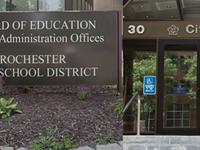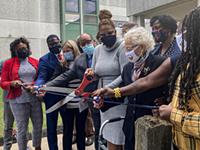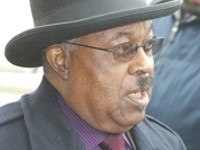He’s out
[
{
"name": "500x250 Ad",
"insertPoint": "5",
"component": "15667920",
"parentWrapperClass": "",
"requiredCountToDisplay": "1"
}
]
He's out
Add one to the list of victims in the US War on Terrorism:Ansar Mahmood. The 26-year-old Pakistani is being deported after spending close to three years in a Batavia detention facility. Barring any miraculous last-minute appeals, it appears Mahmood will be heading back to Pakistan as soon as his travel papers are in order.
"I don't know how the government and congressmen interact. You always hear of these last-minute deals... I guess that's what we're hoping for," says Rajesh Baranabas, a local activist who has taken to Mahmood's cause. "But that's a shot in the dark at this point."
After winning a green-card lottery, Mahmood moved from Pakistan to the city of Hudson, where he was delivering pizzas for Domino's. One day in the fall of 2001, Mahmood took a break from his deliveries to take pictures of fall foliage along the Hudson River. What he didn't realize was that he was standing right next to a municipal water treatment facility. And that's when the trouble began.
Mahmood was eventually cleared of any terrorist activity. But subsequent searches of his apartment revealed that he'd helped a Pakistani couple, here illegally, by co-signing their lease for an apartment and registering their car in his name.
Mahmood was then charged with harboring illegal aliens, which is a felony. Following the advice of his court-appointed lawyer, he pleaded guilty, which automatically subjected him to deportation and detention.
Barnabas has worked with the Chatham Peace Initiative to lobby on Mahmood's behalf. And the group had obtained signatures from 20 members of Congress --- all Democrats --- pleading for Mahmood's release.
"The Homeland Security folks probably just thought it was another political ploy," Barnabas says. "Had we gotten some repubs on board, maybe it would have been different. But they got him... They got him on a technicality, even thought they lost every other argument."
Info: www.chathampeace.org.
Another Kodak moment
Drive along Lake Avenue until you get to the George Eastman Monument. Park. Walk to the monument, go up to the fence, and look in. On the opposite end of the courtyard you'll find building 26, where George Eastman's office used to be. To the right, you'll see a brick building. That's Building Two --- the second building that was built in Kodak Park, in the early 1890s.
Building Two will be torn down in August as Kodak's three-year restructuring plan unfolds. Kodak's plan, as announced in a January press release, is to reduce its worldwide footprint by a third.
Like Building Two, many of Kodak's older buildings have become too inefficient to maintain, says Kodak Spokesman Jim Blamphin. The operations or materials within them, he says, can be moved out into Kodak's more modern facilities.
Kodak officials call their ongoing re-shaping of Kodak Park "revitalization," and many members of the surrounding community agree that the area will change for the better in years to come. More than 60 buildings have already been taken down over the past five years, Blamphin says, and landscaping has already begun to paint the land they once occupied.
Whether unused or underused parking lots will be removed is another story. Residents complain that attractive residential homes used to line the streets where near-empty parking lots now sit. Blamphin can't say for sure whether revitalization plans will remove any underused lots in coming years, but knows that they don't at the moment. Teams are working on landscaping in and around Kodak lots, Blamphin says.
"We've put in a lot of trees, grass, flowers, shrubs, that kind of thing," he says. A team of building managers, he says, take periodic walks around Kodak Park to see "what the public sees" and help improve that view.
The landscaping is necessary --- New York State requires it around parking lots. But landscaping won't make the lots any more useful.
"My concern is what happens then with the parking areas that won't be utilized after all this downsizing and taking down buildings?" says Maplewood Neighborhood Association President Cindy Kaleh. "Will they be developed? Could they be re-developed back into housing?"
Unused or underused lots are partially the result of Kodak's local layoffs. And now they're affecting local tax rolls and aesthetics.
"What the heck is Kodak, the city, Maplewood going to do with the acres of parking lots that are no longer used, that in most cases were once neighborhood tax-producing residential houses?" asks Tom Kunz, a member of the Maplewood Neighborhood Association.
"Hopefully, the 'full-circle' principal will prevail and investors will rebuild the barren asphalt expanses to what they once were," Kunz says.
Stealing from schools
NEC Business Network Solutions Inc. pulled a reverse-Robin Hood recently. The company pleaded guilty in May to abusing the Federal Communication Commission's E-rate Program --- violating anti-trust laws and defrauding schools, among other things --- and it now owes $20.6 million in criminal fines and restitution. And it's not the only company that's recently been accused or convicted of intentionally misusing the sprawling program since it started up in 1998.
The E-rate program, part of the FCC's Universal Service Fund, was established to help under-funded schools and libraries across the nation connect to the Internet. Now, most schools and libraries across the country, including almost all of Greater Rochester's schools and libraries, receive some aid from the program. The discounts --- which range from 20 to 90 percent on telephone service and Internet access --- are based on the National School Lunch Program. So, a higher percentage of free-lunch students attending a school means a higher level of funding.
In Rochester, the biggest user of E-rate funds is --- not surprisingly --- the Rochester City School District. Nearly $900,000 was given in 2003, and a total of $7.5 million has been distributed to the district in the past 6 years. The Rochester Public Library and Hillside Children's Center School received the next highest levels of funding.
A press release issued by the U.S. Justice Department says that an investigation of fraud and anti-competitive conduct in the E-rate program is ongoing.







